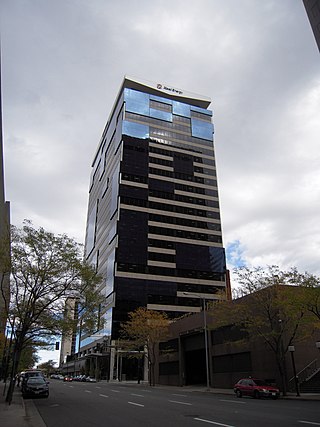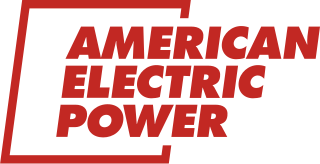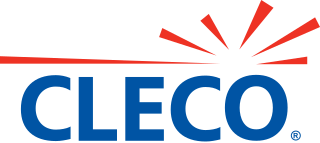Southern Company is an American gas and electric utility holding company based in the Southern United States. It is headquartered in Atlanta, Georgia, with executive offices also located in Birmingham, Alabama. The company is the second largest utility company in the U.S. in terms of customer base, as of 2021. Through its subsidiaries it serves 9 million gas and electric utility customers in 6 states. Southern Company's regulated regional electric utilities serve a 120,000-square-mile (310,000 km2) territory with 27,000 miles (43,000 km) of distribution lines.

Xcel Energy Inc. is a U.S. regulated electric utility and natural gas delivery company based in Minneapolis, Minnesota, serving more than 3.7 million electric customers and 2.1 million natural gas customers across parts of eight states. It consists of four operating subsidiaries: Northern States Power-Minnesota, Northern States Power-Wisconsin, Public Service Company of Colorado, and Southwestern Public Service Co.

American Electric Power Company, Inc. (AEP), is an American domestic electric utility company in the United States. It is one of the largest electric utility companies in the country, serving more than five million customers in 11 states.

Florida Power & Light Company (FPL), the principal subsidiary of NextEra Energy Inc., is the largest power utility in Florida. It is a Juno Beach, Florida-based power utility company serving roughly 5 million customers and 11 million people in Florida. It is a rate-regulated electric utility that generates, transmits, distributes and sells electric energy. In 2020, the company was ranked as the nation's most reliable electric power utility for the fifth time in six years.

The Louisiana and Arkansas Railway was a railroad that operated in the states of Arkansas, Louisiana, and Texas. The railroad's main line extended 332 miles, from Hope, Arkansas to Shreveport and New Orleans. Branch lines served Vidalia, Louisiana, and Dallas, Texas.

Grand Gulf Nuclear Station is a nuclear power station with one operational GE BWR reactor. It lies on a 2,100 acres (850 ha) site near Port Gibson, Mississippi. The site is wooded and contains two lakes. The plant has a 520-foot natural draft cooling tower. As of January 2023, the plant employs 675 people.

River Bend Nuclear Generating Station is a nuclear power station on a 3,300-acre (1,300 ha) site near St. Francisville, Louisiana in West Feliciana Parish, approximately 30 miles (50 km) north of Baton Rouge. The station has one sixth generation General Electric boiling water reactor that has a nominal gross electric output of about 1010 MWe. Commercial operation began on June 16, 1986. In 2003, owners applied and were approved for a power upgrade of approximately 52 megawatts in 2003. The nameplate capacity is 974 MW.
The Waterford Steam Electric Station, Unit 3, also known as Waterford 3, is a nuclear power plant located on a 3,000-acre (1,200 ha) plot in Killona, Louisiana, in St. Charles Parish, about 25 miles (40 km) west of New Orleans.

Constellation Energy Corporation is an American energy company headquartered in Baltimore, Maryland. The company provides electric power, natural gas, and energy management services. It has approximately two million customers across the continental United States.

Harvey Crowley Couch, Sr., was an Arkansas entrepreneur who rose from modest beginnings to control a regional utility and railroad empire. He is regarded as the father of Arkansas Power and Light Company and other electric utilities now part of Entergy; he helped mold the Louisiana and Arkansas Railway and the Kansas City Southern Railway into a major transportation system. His work with local and federal government leaders during World War I and the Great Depression gained him national recognition and earned him positions in state and federal agencies. He also established Arkansas' first commercial broadcast radio station.

Southwest Power Pool (SPP) manages the electric grid and wholesale power market for the central United States. As a regional transmission organization, the nonprofit corporation is mandated by the Federal Energy Regulatory Commission to ensure reliable supplies of power, adequate transmission infrastructure and competitive wholesale electricity prices. Southwest Power Pool and its member companies coordinate the flow of electricity across approximately 60,000 miles of high-voltage transmission lines spanning 14 states. The company is headquartered in Little Rock, Arkansas.
Entergy New Orleans, formerly New Orleans Public Service Incorporated (NOPSI), is an electric and natural gas utility and former mass transit provider that was based in New Orleans, Louisiana.

NextEra Energy Resources, LLC (NEER) is a wholesale electricity supplier based in Juno Beach, Florida. NEER is a subsidiary of NextEra Energy, a Fortune 200 company. Prior to 2009, NextEra Energy Resources was known as FPL Energy.
Entergy Louisiana, Inc. v. Louisiana Public Service Commission, 539 U.S. 39 (2003), is a Supreme Court of the United States case holding that a federal administrative agency approved public utility tariff preempted a state public utilities commission rate order under the filed rate doctrine.

Cleco Corporate Holdings LLC is an electric power company headquartered in the Central Louisiana city Pineville. It operates a regulated electric utility company, Cleco Power, that serves approximately 290,000 retail customers in Louisiana. Cleco also operates an unregulated wholesale electricity business.

NextEra Energy, Inc. is an American energy company with about 58 GW of generating capacity, revenues of over $18 billion in 2020, and about 14,900 employees throughout the US and Canada. It is the world's largest electric utility holding company by market capitalization, with a valuation of over $120 billion as of Nov 2023. Its subsidiaries include Florida Power & Light (FPL), NextEra Energy Resources (NEER), NextEra Energy Partners, Gulf Power Company, and NextEra Energy Services.
Ebasco Services was a United States-based designer and constructor of energy infrastructure, most notably nuclear power plants.

The Electric Bond and Share Company (Ebasco) was a United States electric utility holding company organized by General Electric. It was forced to divest its holding companies and reorganize due to the passage of the Public Utility Holding Company Act of 1935. Following the passage of the Act, the U.S. Securities and Exchange Commission (SEC) selected the largest of the U.S. holding companies, Ebasco to be the test case of the law before the U.S. Supreme Court. The court case known as Securities and Exchange Commission v. Electric Bond and Share company was settled in favor of the SEC on March 28, 1938. It took twenty-five years of legal action by the SEC to break up Ebasco and the other major U.S. electric holding companies until they conformed with the 1935 act. It was allowed to retain control of its foreign electric power holding company known as the American & Foreign Power Company (A&FP). After its reorganization, it became an investment company, but soon turned into a major designer and engineer of both fossil fuel and nuclear power electric generation facilities. Its involvement in the 1983 financial collapse of the Washington Public Power Supply System's five nuclear reactors led to Ebasco's demise because of the suspension of nuclear power orders and lawsuits that included numerous asbestos claims. The U.S. nuclear industry stopped all construction of new facilities following the 1979 nuclear meltdown at Three Mile Island, going into decline because of radiation safety concerns and major construction cost overruns.















